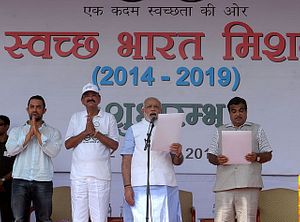On October 2, the birthday of Mahatma Gandhi, Prime Minister Narendra Modi kick-started the five-year “Swachh Bharat Abhiyan,” or Clean India campaign. Stressing how important sanitation is for development, he urged Indians to pay serious attention to basic sanitation, public health, and clean water. Having grown up in a country that has transformed itself from one of the world’s poorest nations to an OECD member, at least in part courtesy of a similar public campaign called the New Village Movement, I cannot but be hopeful that India’s biggest public cleanliness movement would help the country turn its exponential growth potential into reality.
In the aftermath of the devastating Korean War in the early 50s, an exhausted South Korea remained one of the world’s poorest countries for more than a decade, with a per capita GDP lower than most Latin American countries as well as many of its Asian neighbors. In less than half a century however, a once-aid-dependent country turned into Asia’s fourth and the world’s 15th largest economy, and recently became the seventh country in the world to join the exclusive “20-50 Club,” a term used to describe industrialized countries with more than 50 million people and per capital income of over $20,000. Hosting the G-20 Summit in 2010 and the Nuclear Security Summit in 2012, South Korea has proven to the world that it is now a legitimate middle power, with the ability to influence the agenda of multilateral forums.
South Korea’s successful economic ascent is almost always cited along with its export-oriented industrialization strategy. In fact, this typical East Asian economic development model is what Modi is hoping to emulate through the “Make in India” campaign, which aims to turn the country into a global manufacturing hub. Unsurprisingly, Goldman Sachs recently recommended in its “How India can become the Next Korea” report that India could and should adopt the Korean model, considering there is a remarkable resemblance between the current Indian economy and the South Korean economy of the 1970s.
An outward looking policy has allowed South Korea to boost its industrialization process. However, a milestone for its rapid economic development was the New Village Movement (Saemaul Undong in Korean) initiated by President Park Chung-hee, father of the current President Park Geun-hye, in the early 1970s, which sought to lift rural Korea out of poverty and modernize its rural economy. It is now heralded as one of the most successful rural development stories in the modern world, and the UN Economic Commission for Africa even decided to adopt the movement as a model for its Sustainable Modernization of Agriculture and Rural Transformation program in 2008. Interest in learning from this success story has risen rapidly among developing countries, and in response the South Korean government has promoted the New Village Movement as a key element of its foreign assistance, exporting it to more than 70 countries around the globe.
Based on the principle of diligence, self-help and collaboration, the movement focused on encouraging the people living in rural areas to take an active role in building their own communities. The government provided large agricultural subsidies, particularly in rice production, and invested heavily in modernizing and improving rural infrastructure such as irrigation systems and roads. When the movement subsequently expanded to urban areas, it began to focus on developing a cleaner and more comfortable urban environment. By 1974, the government had designated one hour a month of “Saemaul time” to encourage households, schools and corporations to clean up their neighborhoods.
For South Koreans, cleaning didn’t end there. Better sanitation, cleaner water, and more modern infrastructure were provided; however beyond the financial and physical assistance of the government, this participatory development policy pushed people to develop self-reliance and a “can do” spirit. It also encouraged people to have more ownership of their neighborhoods, communities and lives, as well as strengthening solidarity among people, which in turn fueled faster economic development.
When announcing the Clean India campaign, Modi said that part of its purpose was to change mindsets. If Korea’s experience can be of any guidance, the campaign could not only change Indians’ perception of sanitation, but also mobilize its people to return to the economic success India was enjoying in the mid-2000s. Sweeping may clean Indian roads, but it will also help people develop a self-independent and growth-oriented mindset, and empower them to achieve poverty eradication, improve their quality of life, and push their country toward economic development.
An old proverb says “Give a man a fish, and you feed him for a day; teach a man to fish, and you feed him for a lifetime.” Rather than aiming for visible achievement in the short term, which might help Modi to win the next election, the determined prime minister is hoping to bring gradual, yet profound and systemic change to India. It is not yet known whether the campaign will enjoy the success South Korea’s version did, but what is certain is that at least Modi is going in the right direction.
Soyen Park is a senior researcher in the economic section at the Embassy of the Republic of Korea in India and a Ph.D Candidate at Korean University. The views expressed in this article are those of the author and do not necessarily represent the views of, and should not be attributed to, the Korean Embassy in India or the South Korean government.

































